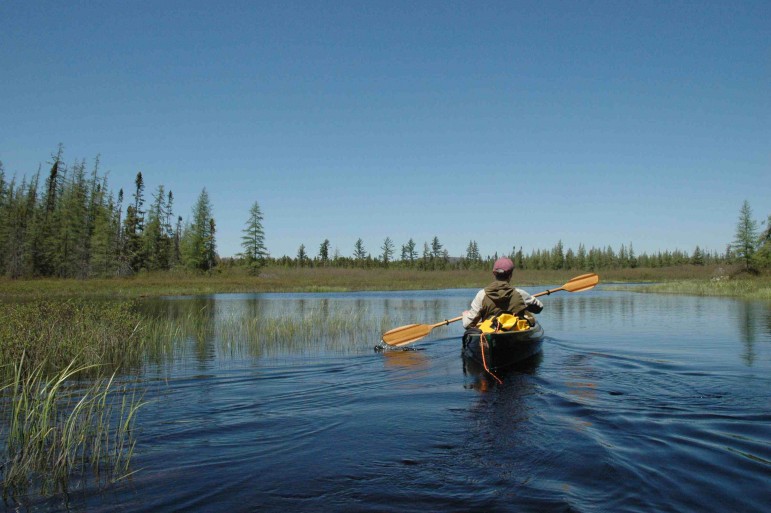
Adirondack Explorer Editor Phil Brown canoeing the Mud Pond waterway in May 2009. Image: Susan Bibeau. (One time use; republication rights not available from Great Lakes Echo.)
By Holly Drankhan
A two-day canoe trip has sparked a six-year dispute over navigation rights in New York waterways.
Depending on how it is settled, it could mean that waterways bordered by private land are open to public recreational use.
Defenders of public water use were supported by a Jan. 15 decision by the Appellate Division of state Supreme Court. But landowners plan to ask the state’s highest court for review.
The dispute began in May 2009 when Phil Brown, an editor of the nonprofit magazine Adirondack Explorer, canoed from Little Tupper Lake to Lake Lila in the Adirondacks.
Both bodies of water lie within the 14,700-acre William C. Whitney Wilderness Area in Hamilton County. The state acquired the land in 1997.
On the second day of his trip, instead of carrying his canoe for .8 of a mile on state-owned land, Brown paddled a two-mile stretch known as the Mud Pond waterway. It consists of Mud Pond, Mud Pond Outlet and a portion of Shingle Shanty Brook.
The land bordering the waterway is privately owned by Friends of Thayer Lake and the Brandreth Park Association, which posted “no trespass” signs and placed cables across the waterway.
Brown published the details of his excursion a few months later, describing the waterway as providing “closeness to nature, ever-changing scenery, remoteness from roads.”
Following the article’s publication, the owners sued him for trespassing.
“The point of the article in part was to describe the trip, but mainly it was to discuss the whole issue of navigation rights, because a lot of people I had talked to said they thought this waterway should be open to the public, but it had been posted for years and there was a cable across Shingle Shanty Brook,” said Brown.
“So I believed I had a right to go down that stream,” he said.
The New York State Department of Environmental Conservation supported Brown’s defense in court. Brown and the department agreed that the waterway should be considered “navigable-in-fact” under state law because it has “practical usefulness to the public as a highway for transportation.”
That distinction would make Mud Pond waterway available for a number of public uses, including canoeing.
Brown and the state of New York argued that recreation is a “practical usefulness to the public” and is sufficient for establishing Mud Pond waterway as navigable-in-fact.
Dennis Phillips, the landowners’ attorney, argued that the navigability law applies only to waterways with a proven capacity for commercial use, and Mud Pond waterway does not have this potential.
“It was only intended to help people get things to market in terms of going from town to town, or from store to store, or from mill to mill,” said Phillips of the navigability law.
Recreational and commercial uses are not necessarily unrelated, said Pace Law School professor John Humbach, who has published several reviews of New York navigability legislation. Tourism, including canoe and kayak tours, is important to the Adirondack region.
Approximately 50 clients of St. Regis Canoe Outfitters in Saranac Lake, New York, would use the waterway if it were open to avoid the portage on public land, company owner David Cilley said in a court document.
In 2011, a Hamilton County judge decided that the waterway is open to the public. The judge also ruled that landowners created a “public nuisance” with the posted signs and cables that deterred paddlers.
The landowners appealed. But in January, the Appellate Division of state Supreme Court agreed that it should be open to the public.
The owner of a hunting cabin on the property testified that the waterway had a history of use by landowners for hunting and fishing as well as the transport of food, baggage and building materials.
Justice Elizabeth Garry wrote in the majority opinion, “The landowners’ longstanding use of the waterway to transport goods and materials for private use reveals that it has the capacity to transport similar goods for commercial purposes.”
Justice Robert Rose disagreed, and wrote a minority opinion that said the waterway is “so narrow in spots that a rowboat cannot navigate them because its oars will hit the banks, and the water course meanders, twists and turns back upon itself, with beaver dams, downed trees and dense vegetation growing out from the banks and up from the bed.”
The clearing of natural debris by landowners made the water passable, he said.
Phillips said his clients will ask the Court of Appeals, New York’s highest court, to review the case.
“When the majority says there is no question about whether this was private property going back to 1851, and the dissent says this decision by a majority would disturb settled notions of property in the state of New York, then it appears as though there is a need for a higher court to sort out the concerns and the law as applied to this particular piece of property,” said Phillips.
Unless the decision is overturned by the Court of Appeals, Brown said that it will have major implications for recreational users.
“If they rule in favor of us and uphold the lower court opinions, I think it will help clarify paddler’s rights throughout the state and perhaps open up waterways that should not be posted and that are posted,” said Brown.